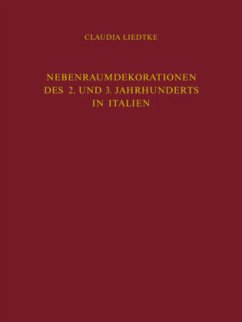This study concerns itself with the 'monochrome' mural paintings of the Middle and Late Imperial Age in Italy. The paintings are to be found in bedrooms, corridors and domestic offices, but also in the more humble living quarters of the poorer classes in society. What are known as 'ancillary room decorations' have not hitherto been regarded as a decorative genre in their own right. The study shows, however, that they also go through a process of stylistic development independently of the style of the principal rooms, and that a chronological assessment of them is possible. The mural paintings, most of them previously unpublished, come mainly from Rome and Ostia and are presented in a catalogue. They also allow conclusions to be drawn about the history of domestic living from the Hadrianic to the post-Severian period.
Thema der vorliegenden Untersuchung ist die 'monochrome' Wandmalerei der mittleren und späten Kaiserzeit in Italien: Sie findet sich in Schlafräumen, Korridoren und Wirtschaftsräumen, aber auch in den eher bescheidenen Wohnräumen der ärmeren Bevölkerungsschichten. Diese sogenannten 'Nebenraumdekorationen' sind bisher nicht als eine eigenständige Dekorationsgattung betrachtet worden. Doch zeigt sich, daß auch sie eine - von den Hauptraumdekorationen unabhängige - stilistische Entwicklung durchlaufen, die eine chronologische Beurteilung ermöglicht. Die überwiegend aus Ostia und Rom stammenden, weitgehend unpublizierten Wandmalereien sind in einem Katalog zusammengestellt. Sie erlauben überdies Rückschlüsse auf die Geschichte des Wohnens von der hadrianischen bis zur nachseverischen Periode.
Thema der vorliegenden Untersuchung ist die 'monochrome' Wandmalerei der mittleren und späten Kaiserzeit in Italien: Sie findet sich in Schlafräumen, Korridoren und Wirtschaftsräumen, aber auch in den eher bescheidenen Wohnräumen der ärmeren Bevölkerungsschichten. Diese sogenannten 'Nebenraumdekorationen' sind bisher nicht als eine eigenständige Dekorationsgattung betrachtet worden. Doch zeigt sich, daß auch sie eine - von den Hauptraumdekorationen unabhängige - stilistische Entwicklung durchlaufen, die eine chronologische Beurteilung ermöglicht. Die überwiegend aus Ostia und Rom stammenden, weitgehend unpublizierten Wandmalereien sind in einem Katalog zusammengestellt. Sie erlauben überdies Rückschlüsse auf die Geschichte des Wohnens von der hadrianischen bis zur nachseverischen Periode.

